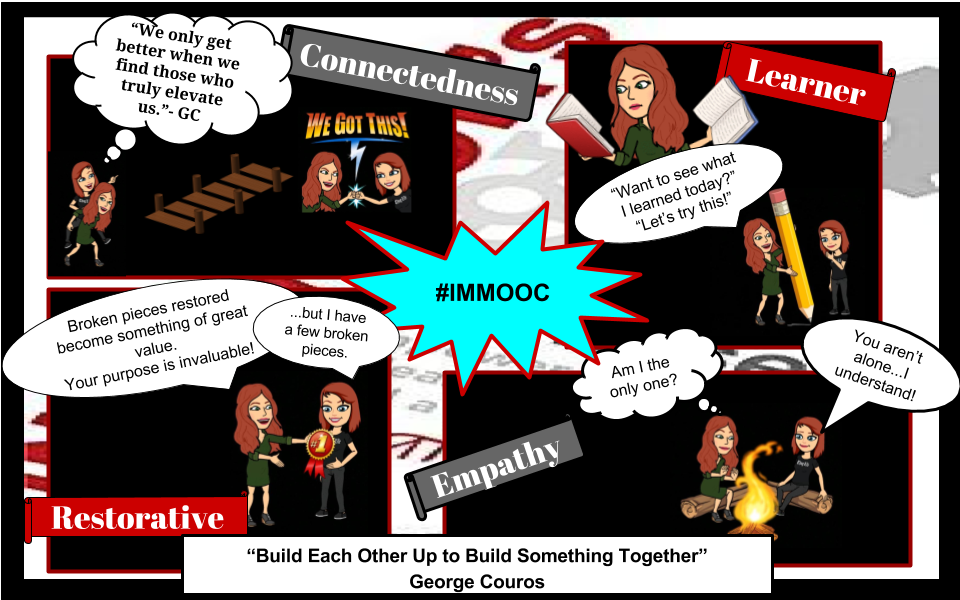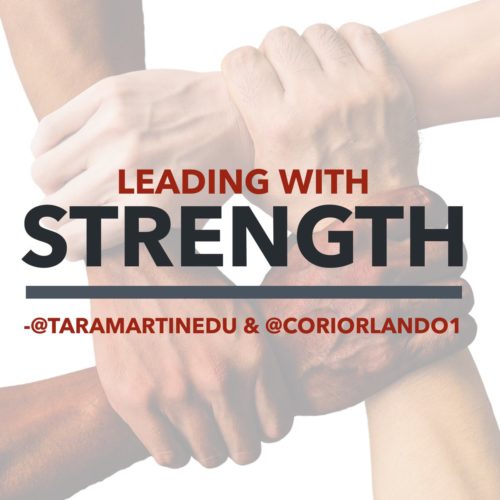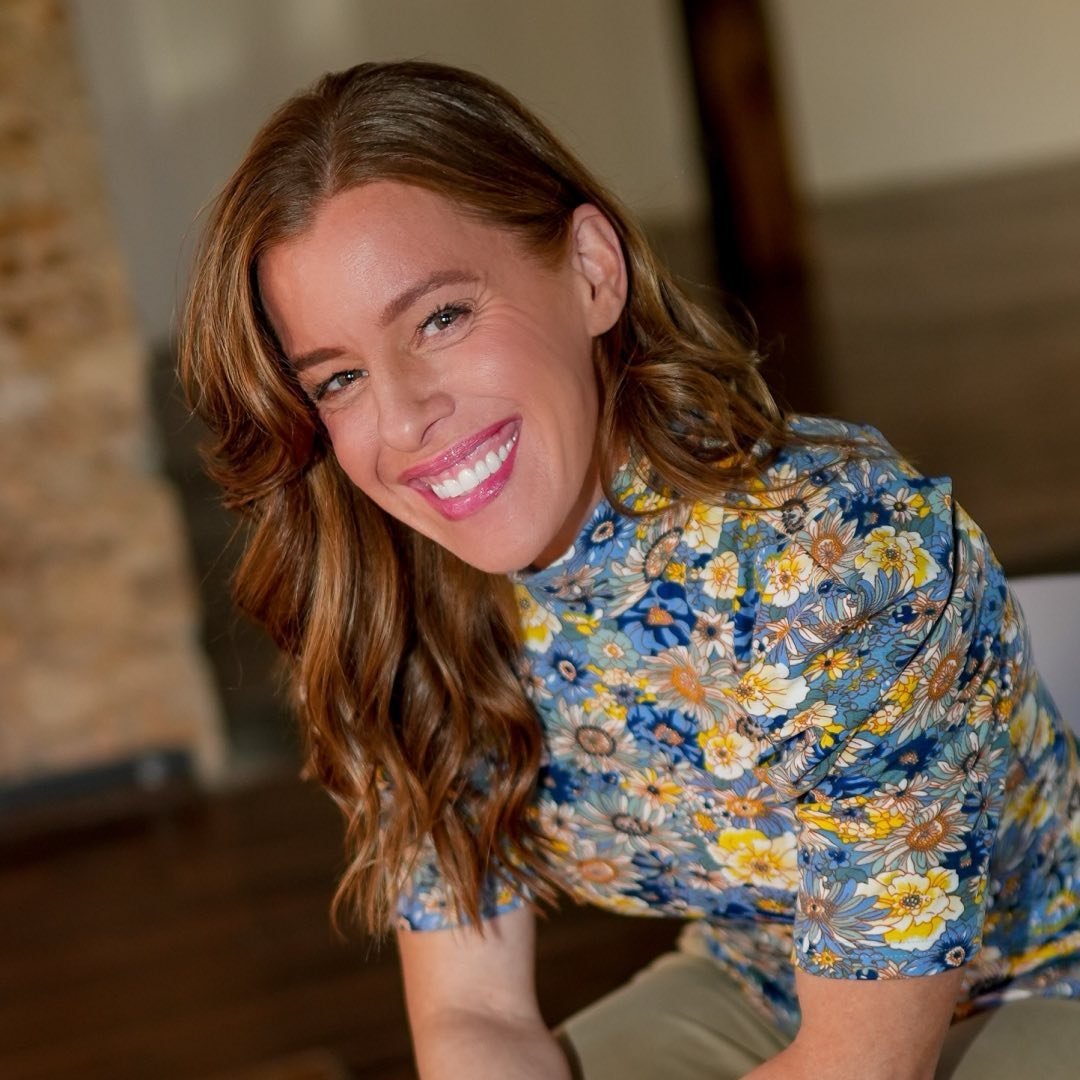This is a “buddy blog” written with my friend Cori Orlando for #IMMOOC week 4. Check out her blog: Leading in Limbo.
Leading with Strength
 What determines an organization’s success? As Todd Whitaker once said, “It’s people, not programs. Programs are never the problem and are never the solution.” It is the people; it has always been the people. Sometimes we choose the people; sometimes they are chosen for us. Regardless, we are tasked with creating a collaborative team and culture to promote forward movement of the organization. Therefore, we must take stock in OUR people. Get to know them…really know them. What are their passions, what are their strengths? This is important. George Couros writes: “…everything you need may already exist within your organization. Your job is to unleash talents of your staff members.” I (Cori) liken this to the quote from Wizard of Oz. “Everything you were looking for was right there with you all along.” We shouldn’t be looking outside for the answer but within our team. Everyone has their own strengths; we need to harness and grow that. How can we play off of each other’s strengths and support each other’s weaknesses? A great place to start is the Gallup Strengthsfinder. Both Tara and I have gone through the survey and will be discussing our results and how we implement them in our daily practice as educational leaders.
What determines an organization’s success? As Todd Whitaker once said, “It’s people, not programs. Programs are never the problem and are never the solution.” It is the people; it has always been the people. Sometimes we choose the people; sometimes they are chosen for us. Regardless, we are tasked with creating a collaborative team and culture to promote forward movement of the organization. Therefore, we must take stock in OUR people. Get to know them…really know them. What are their passions, what are their strengths? This is important. George Couros writes: “…everything you need may already exist within your organization. Your job is to unleash talents of your staff members.” I (Cori) liken this to the quote from Wizard of Oz. “Everything you were looking for was right there with you all along.” We shouldn’t be looking outside for the answer but within our team. Everyone has their own strengths; we need to harness and grow that. How can we play off of each other’s strengths and support each other’s weaknesses? A great place to start is the Gallup Strengthsfinder. Both Tara and I have gone through the survey and will be discussing our results and how we implement them in our daily practice as educational leaders.
Finding Strengths
George Couros says, “We cannot forgo a focus on our strengths for the sake of only emphasizing the areas where we struggle.” I (Tara) couldn’t agree more. When “educators overcompensate in the areas that need to be fixed, the “great things that were already happening are quickly forgotten.” A few years ago, in grad school, I read Now Discover Your Strengths by Marcus Buckingham and Donald Clifton. Within the book is a secret code to take the StrengthsFinder and determine the top five strengths. After receiving my results, of learner, focus, strategic, restorative, and achiever, I began to study what each of these natural-born talents implies and how I might use them to become a stronger educator.
Side note: The StrengthsFinder is based on a general model of positive psychology. It captures personal motivation, interpersonal skills, self-presentation and learning styles. The idea behind the test is to determine your strongest synapse connections in your brain–also known as your talents.

Tara’s Puzzle Piece
What’s my piece of the puzzle? For the sake of this buddy blog, I would like to highlight two of my strengths and how I use them as an educational leader. The first one might as well be next to my name on my birth certificate–learner. Honestly, I’m thankful for this “carefully forged synaptic connection” within my brain! Learner is to educator as peanut butter is to jelly. Bad analogy, but you get the point. The Innovator’s Mindset has taught me that being a learner is great, but it’s what you do with that knowledge that’s empowering. While I’m always learning and growing, I strive to practice what I preach. Before asking an educator to try something new, I make certain to dive in head first. For example, a few “new to me” learning outcomes are my website, #BookSnaps, speaking in front of a large crowd, blogging, keynoting, and vlogging. Even when suggesting a new teaching strategy, I’ll ask the classroom teacher, “Do you mind if I come out and try this with your students? I want to know what it feels like in real-time–with REAL kids.” Being a learner is more than retaining new knowledge, it’s doing, sharing, innovating and knowing you will NEVER reach a plateau–all while stretching others to step out of their comfort zone and try something new, too.
When restorative showed up as one of my top five “talents” or strengths, I couldn’t help but wonder, “Really? In what ways do I restore?” However, the more I studied it, the more I found it intriguing. As explained by Marcus Buckingham, “You enjoy bringing things back to life.” You “identify the undermining factor(s), eradicate them and restore something to its true glory.” That certainly describes how my mind works. In fact, in the education world, I enjoy searching for the hidden talents of students and educators. I love learning about their passions while collaborating with them and helping them take what seems to be broken and turn it into something full of purpose. Maybe this strength comes from growing up in a less than stellar home life and learning to see a tiny light of positive in a very dark place? However, many times it’s merely shifting the focus off their weaknesses and playing to their strengths. My role is to empower others to stop “living a second-rate version of someone else’s life” and begin living “a world class version of their own.” (Buckingham and Clifton) In the Innovator’s Mindset, George Couros says, “By focusing on strengths first and building from there, as opposed to working from a deficit model that focuses only on where we need improvements, we create an environment where people feel they have a purpose…” I’m thankful for my strong synaptic connections–my talents. Once I learned them, I use them to my advantage in my everyday life. However, it’s not all about me–it’s all about finding others’ strengths and creating ways for them to feel this same excitement–doing what they love.
Cori’s Piece of the Puzzle
I took the Gallup Strengths find a few years ago, and was not surprised with the results. My strengths are (in order): Empathy, Achiever, Ideation, Relator, Connectedness. Like Tara, I was not surprised by my top “strength”-Empathy. Anyone that knows me or has read anything I have written, knows that Empathy is kinda my “thang.”The Gallup Strengthsfinder states: “ People with strong Empathy talents can sense the emotions of those around them.They can feel what others are feeling as though the emotions were their own. They intuitively see the world through others’ eyes and share their perspectives.” That pretty much sums me up. I like to call this “reading the room.” How does this play out in an educational leadership role? I believe to create change, to move people and an organization forward, we need to KNOW our people. We need to understand their point of view AND take it into consideration. It is important to look at things from a circle of viewpoints to make the best decision for all. This is the piece that I feel I can bring to the table. I try to use this “power” for good and help others to view things from multiple perspectives. I am often called a “Pollyanna” because of this, but I will take it, as long as it is helping others to grow in their journey.
I also believe that my empathy has helped me to create authentic relationships and build trust with the people I work with and support. These relationships are the foundation that is needed to help others to collaborate and grow. People will not let their guard down, open up to share or receive help without this important piece. I truly care about all the people I work with, and I hope that comes across in my interactions. This idea of relationship building leads right into my next “strength”..
For this post, I have decided to discuss the last strength on my list, because it is one that I feel incredibly passionate about – Connectedness. According to Gallup: “People strong in the Connectedness theme build bridges between people and groups, showing them how to relate to and rely on each other. They help others find meaning in the unpredictability of the world around them, providing a sense of comfort and stability in the face of uncertainty.” This just so happens to be one of my professional goals, connecting people. I believe that we NEED others; we really do. I work hard to create time, space and opportunities to bring good people together (in person and/or virtually). I know so many talented, passionate, amazing people; each with their own unique strengths. I love when I can bring some of them together wrapped around common ideas/interests. I just smile when I can say- “Oh, you should talk to___ they are also doing ____.” I try really hard to connect people across sites, grade levels, subject areas, districts, cities and even states. This cross-collaboration is so important, and I have witnessed amazing things stem from it.
The second half of the “connectedness” definition talks about helping others find the meaning in unpredictability. Well, I am always trying to connect the dots for myself, and freely share my stories in the hopes to help others. When someone comes to me, struggling; I try to comfort them, assure them that they are not alone, help them remember their purpose, unstick the stuck and keep moving them forward. My hope is that people do feel a sense of comfort when we connect. It is always nice to have someone to listen, hear and understand. My hope is that I can be that for others.
“Build Each Other Up To Build Something Better”-George Couros
After analyzing our results, we are impelled to identify the strengths of others and how we might form a dynamic team with diverse talents and passions. Not only does Buckingham and Clifton emphasize the need for strengths-based teams, George Couros says, “When each individual is recognized for his or her own unique qualities and how those strengths support the overall vision of learning for our school, we can truly transform our schools.” We need each other. How might your unique passions and talents help transform your school or district? How would your strengths complement ours to form a dynamic team? We would love to hear from you!



